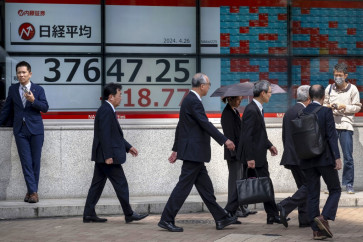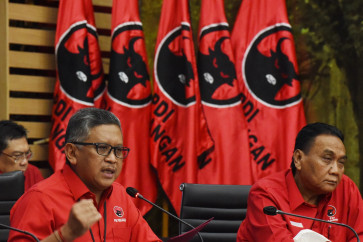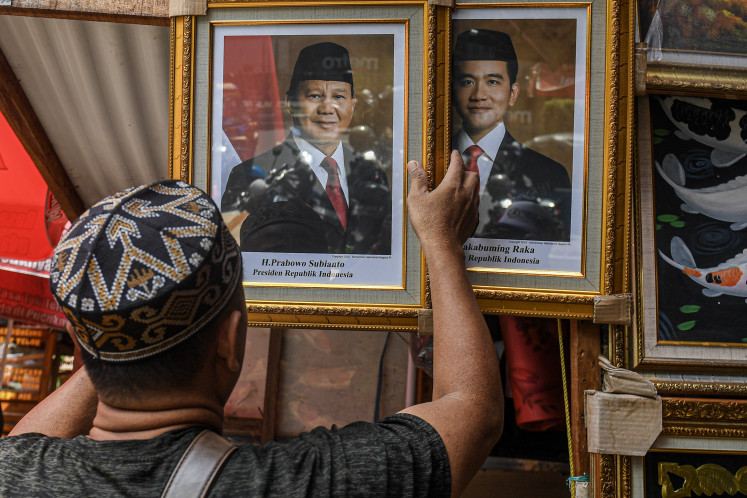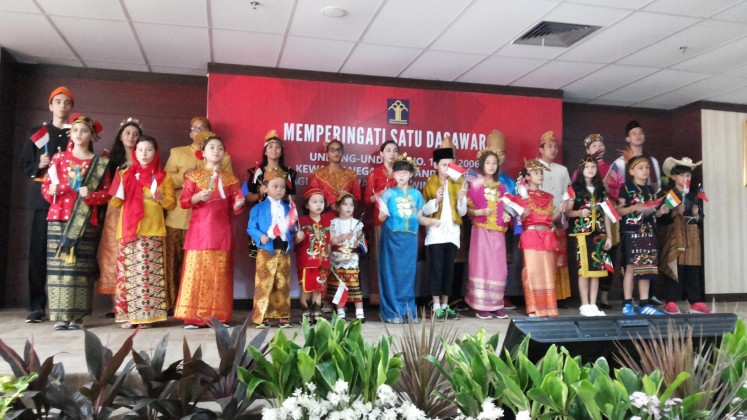Indonesian art gets center stage in Europe
This summer witnessed the showcasing of two important exhibitions of Indonesian contemporary art in London and Paris, the world’s capitals of art
Change Size

T
his summer witnessed the showcasing of two important exhibitions of Indonesian contemporary art in London and Paris, the world’s capitals of art.
Heri Dono (above) Melia Jaarsma (below)— Photo Courtesy of the Louis Vuitton Cultural Space
In Paris, critics were very positive about “Transfigurations, Mythologies Indonesiennes”, a show that runs until Oct. 23 at the Louis Vuitton Cultural Space, located on the prestigious Champs Elysées. The show involves 11 artists, including an architect and a noted filmmaker.
The 16th show at the center, directed by Marie-Ange Moulonguet, was realized after French travel writer Alice d’Orgeval visited Yogyakarta two years ago. D’Orgeval was so enthusiastic about her visit that she immediately informed Herve Mikaeloff, the exhibition’s curator, about the cultural pride in Indonesia, particularly in Central Java.
Guided by French writer Elisabeth Inandiak, who is a long-time resident of Yogyakarta, and by Marie Le Sourd, who has recently retired after serving as director of the French Cultural Centre in Yogyakarta for five years, Moulonguet and Mikaeloff then visited Indonesia themselves.
During their visit in late July last year, the two met numerous artists including the famous collector Oei Ong Djien. They discovered that Yogyakarta’s lively art scene lacked a permanent collection of contemporary art. They soon decided on an exhibition in Paris.
Elisabeth Inandiak was enthralled with the cultural space provided for the exhibition.
The 11 participating Indonesian artists, Heri Dono, Arie Dyanto, Mella Jaarsma, Agung Kurniawan, Jompet Kuswidananto, Eko Nugroho, Garin Nugroho, Ariadhitaya Pramuhendra, Eko Prawoto, Bayu Widodo and Tintin Wulia, were equally impressed, especially with the space, which ran around the core of the imposing Art Nouveau building and resembled several consecutive art galleries and artist studios.
Visitors must take a darkened lift to prepare for the change in environment once they enter the exhibition.
Outside, Mella Jarrsma’s huge installation object, The Fire-eaters, attracts passing pedestrians with its vivid colors and patterns.
At the entrance lobby, architect Eko Prawoto’s riveting bamboo sculpture seduces onlookers waiting for the lift.
Le Sourd talked about venues in Yogyakarta where artists exhibit their work, either in their own atelier or in new cultural venues, such as cafes or galleries that are quickly emerging.
“For me, the atmosphere in the Vuitton space is similar to the casual feeling of Yogya’s art studios,” she said during a discussion held in early September, which also featured Inandiak and Decrop, a Hong Kong-based French expert on Asian art.
Decrop is no stranger to Indonesian art. Several years ago he was co-curator of a show at the Loft Gallery in Paris, which featured the works of renowned Indonesian artists such as Heri Dono, Astari and Pintor Sirait.
Inandiak talked about the development of artistic expression in Yogya during the 20 years she has been a resident. Unfortunately, no Indonesian expert attended the discussion to present a viewpoint.
At the Paris exhibition, Heri Dono incorporates abstract and contemporary visuals into his installations, which find their origin in Indonesian traditional art forms, such as wayang puppets, while Arie Dyanto utilizes stencil print and murals in his modern-day interpretation of Indonesian art. Meanwhile, Agung Kurniawan, inspired by political messages, uses fine wire sculptures that focus more on daily life.
Jompet Kuswidananto is still heavily inspired by his native Java and its cultural history. He displayed his series Pilgrims and Plagues in twilight colors and with cut-out forms, plus with a set of nostalgic sepia photos entitled War of Java, Do you remember?
His contribution contrasted sharply with Eko Nugroho’s vibrant comic strip style, while filmmaker Garin Nugroho, who lives in Jakarta but was born in Yogyakarta, presented a series of photo collage installations reminiscent of his various films.
A presentation by Ariadhitaya Pramuhendra, who also works in Jakarta and is best known for his charcoal work, focuses on the differences between French and Indonesian people and culture.
Bayu Widodo produces small, intense drawings on paper that reflect his environment in the form of a visual dairy.
Tintin Wulia was born in Bali but now lives in Yogyakarta after having studied at the Berklee School of Music in Boston. At first, Tintin made films but then became involved with installations, such as the one here in Paris, which took the form of hundreds of passports inviting the public to reflect on the seemingly arbitrary notion of nationality.
In London, the first important presentation of Indonesian art in England was on display at the renowned Saatchi gallery.
The atmosphere at the exhibition was different, not only because of its contents but also due to the use of two huge white spaces to display works by renowned Indonesian artists, such as Heri Dono, Mella Jaarsma and Jompet Kuswidananto. The works of these artists are also being exhibited in Paris.
Some of the modern art at the London show, entitled “Indonesian Eye, Fantasies and Realities”, caused feelings of déjà vu among its audience.
The works reminded some European observers of 1980s art, while others had difficulty understanding references to traditional Indonesian culture or art. Many were even reminded of famous American artist Basquiat’s urban graffiti two decades ago.
Overall, the exhibited works both in Paris and London offered plenty of food for thought and reflection for the European public, bridging the so-called gap in cultural understanding between East and West.









